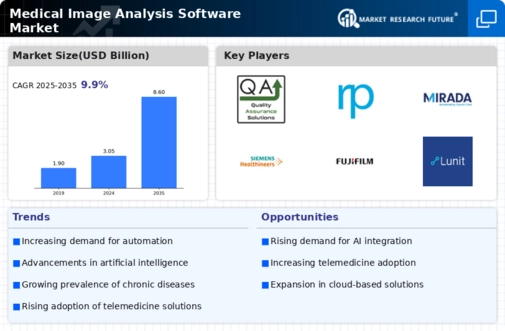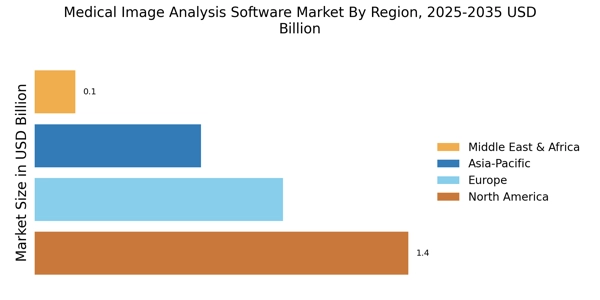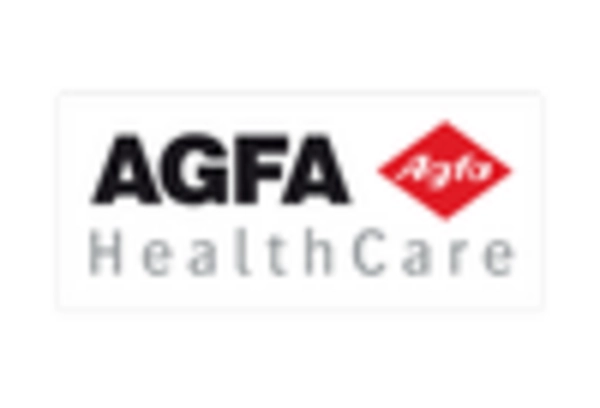Rising Demand for Diagnostic Imaging
The increasing prevalence of chronic diseases and the aging population are driving the demand for diagnostic imaging services. This trend is particularly evident in the Medical Image Analysis Software Market, where the need for accurate and timely diagnosis is paramount. According to recent data, the market for diagnostic imaging is projected to grow significantly, with a compound annual growth rate (CAGR) of approximately 6.5% over the next several years. This growth is likely to spur advancements in medical image analysis software, as healthcare providers seek to enhance diagnostic accuracy and improve patient outcomes. As a result, the Medical Image Analysis Software Market is expected to witness substantial investments aimed at developing innovative solutions that cater to the evolving needs of healthcare professionals.
Growing Focus on Personalized Medicine
The shift towards personalized medicine is reshaping the Medical Image Analysis Software Market. As healthcare providers increasingly recognize the importance of tailoring treatments to individual patient profiles, the demand for software that can analyze imaging data in conjunction with genetic and clinical information is rising. This trend is supported by the growing body of research indicating that personalized approaches can lead to improved patient outcomes. The market for medical image analysis software is expected to expand as developers create solutions that integrate imaging data with other health information, enabling more precise treatment planning. This evolution reflects a broader movement within the healthcare sector towards data-driven decision-making, which is likely to further propel the Medical Image Analysis Software Market.
Technological Advancements in Imaging Techniques
Technological innovations in imaging modalities, such as MRI, CT, and ultrasound, are transforming the landscape of the Medical Image Analysis Software Market. These advancements not only enhance image quality but also facilitate the integration of sophisticated software solutions that can analyze complex data sets. For instance, the introduction of 3D imaging and real-time analysis capabilities has significantly improved diagnostic precision. The market is anticipated to expand as healthcare facilities adopt these advanced imaging technologies, which are projected to increase the demand for specialized software that can process and interpret the resulting data. Consequently, the Medical Image Analysis Software Market is likely to experience a surge in the development of tools that leverage these technological advancements to provide better diagnostic support.
Increased Investment in Healthcare Infrastructure
Investment in healthcare infrastructure is a critical driver of growth in the Medical Image Analysis Software Market. Governments and private entities are allocating substantial resources to enhance healthcare facilities, particularly in emerging economies. This investment often includes the acquisition of advanced imaging equipment and the corresponding software necessary for effective analysis. As healthcare systems modernize, the demand for medical image analysis software is expected to rise, driven by the need for efficient diagnostic tools that can support a growing patient population. Furthermore, the establishment of new healthcare facilities is likely to create additional opportunities for software vendors, as these institutions seek to implement cutting-edge technologies to improve service delivery. Thus, the Medical Image Analysis Software Market stands to benefit from this trend of increased healthcare investment.
Regulatory Support for Advanced Imaging Technologies
Regulatory bodies are increasingly supporting the adoption of advanced imaging technologies, which is positively impacting the Medical Image Analysis Software Market. Initiatives aimed at streamlining the approval process for innovative imaging solutions are encouraging manufacturers to invest in research and development. This regulatory environment fosters the introduction of new software that enhances the capabilities of existing imaging systems. As regulations evolve to accommodate technological advancements, the market is likely to see a proliferation of software solutions designed to meet these new standards. This trend not only promotes innovation but also ensures that healthcare providers have access to the latest tools for accurate diagnosis and treatment planning. Consequently, the Medical Image Analysis Software Market is poised for growth as regulatory support continues to drive advancements in imaging technologies.


















Leave a Comment